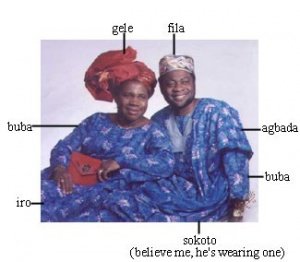Clothing
From The Peopling of New York City
Contents |
West African Traditional Attire
African immigrants take pride in their customs and culture. One major part of their culture is their traditional clothing. The bright colors, designs, and patterns are unique and enable African Americans to bring a part of their rich culture into the United States. Many immigrants either bring material from Africa here and make the clothes themselves, contact relatives still living in Ghana, Nigeria, or Liberia to make them and send them, or purchase the fabric and make them here. Some wear this attire everyday, and some save it for Sundays when they can travel to church and be seen with their fellow parishioners in similar clothing. From a firsthand experience, the first thing one notices when one walks into an African church, is the amazing variety of colors outfitting everyone. The colors and fabrics are amazing and include materials such as lace, jaquard, adire, and ankara.
Every piece of clothing has a name and a certain way of wearing. For example, in Nigeria, women wear a buba, which is a loose neck blouse with long sleeves that goes a little past the waist. The iro is the bottom part of an outfit which is wrapped around the waist and is folded to stay in place. The headpiece is an integral part of Nigerian attire. It is also known as the gele; it can be folded or tied in many different ways and styles. A scarf piece that is worn around the neck or is tied diagonally across the body is called the iborun. Lastly, the saba is a dress made in many different fabrics, colors, and styles.
Nigerian men also have a certain attire that reflects their culture and tradition. This clothing consists of many pieces which culminate to create a unique, colorful, ethnic look. The male buba is the same as the women’s, except the male blouse is a little longer. To accompany the buba, men wear sokotos, or traditional pants. The fila, paralleling the women’s headpiece, is the round hat that is worn on their heads. The agbada is a very long V-neck shaped piece of cloth with wide arms that usually hits the floor; this is worn on important occasions over the buba and sokota. In other African communites, men and women wear wrappers. Wrappers are long pieces of fabric that are wrapped and pleated around the body and made into dresses, skirts, and even pants.
How to Tie a Gele
No matter who you are, you can learn how to tie and wear an African headpiece, or gele!
1. Start by folding the head fear piece to a width of about 6 inches.
2. Wrap the piece around your head with the right extending about one and half of the left side.
3. Push in the left side but keep the ends out while crossing the right side over (on top of the left end); also keep the right-side ends out.
4. Pull both ends as tight as desired. Push the left side while pulling the right side to get the desired comfort.
5. Push in the right side only from where it touches the left side but without pulling it all the way through. This forms a bow.
6. Either move this bow to the front, side or leave it on the back.
7. Spread out the two ends to obtain a rose petal look, or pin the two ends to obtain yet another look. The different styles and looks are endless.
West African Couture

African traditional clothing is now becoming a part of runway shows and is being turned into couture, allowing up and coming African immigrant designers a chance to get in the spotlight. An organization that demonstrates the aforementioned is called Runway Africa; it is a noteworthy group because the profits made from their events goes back to West Africa and other parts to find cures for children with HIV/AIDS. A particular collection known as "Runway Africa:Celebrating African Fashion" does exactly that. The link above leads to an article written in Mshale, an african immigrant newspaper on this amazing new movement of fashion.
Clothing from Ghana

"These men are members of the Akan people of Ghana. Their clothing is ceremonial, as are the linguist staffs they carry. They are probably preparing to dance in a funeral ritual; red is one of the colors of mourning in Ghana."(MSN Encarta)
Clothing from Nigeria

"This Nigerian man wears loose, flowing robes lavishly decorated with appliqué and embroidery. His headdress helps keep his head cool in the hot climate."(MSN Encarta)
